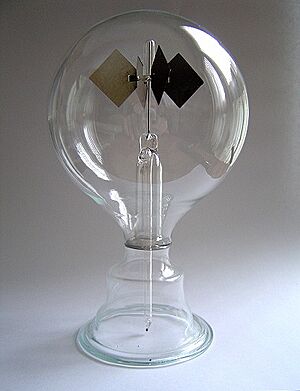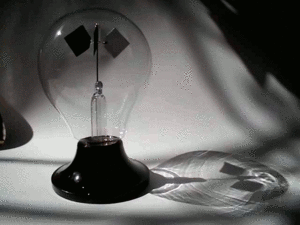Crookes radiometer facts for kids
The Crookes radiometer, often known as a light mill, is a cool device. It's a sealed glass bulb with most of the air taken out (a partial vacuum). Inside, there are light vanes (like tiny windmill blades) on a spinning rod. When light shines on it, the vanes spin! The brighter the light, the faster they go. This can even help measure how strong light is.
For about ten years after it was invented, scientists argued about why it spun. But in 1879, they finally figured out the real reason. Today, we mostly use it in science classes to show how light energy can make things move, like a tiny engine.
Sir William Crookes, a chemist, invented it by accident in 1873. He was doing very careful weighing experiments in a chamber with less air. He noticed his measurements changed when sunlight hit his balance. He investigated this strange effect and ended up creating the radiometer named after him.
You can still buy these devices today. They are fun educational tools or just interesting decorations.
Contents
What is a Crookes Radiometer?
A radiometer is a glass bulb with most of the air removed, creating a partial vacuum. Inside, there's a rotor with usually four light vanes. These vanes are spread out evenly around a central rod that spins easily. One side of each vane is shiny or white, and the other side is black.
When sunlight, bright artificial light, or even heat (like from your hand nearby) hits the radiometer, the vanes start to turn. The black sides move away from the light source, and the shiny sides move forward.
If you cool the outside of the radiometer very quickly, the vanes will spin in the opposite direction!
How the Light Mill Reacts to Different Air Levels
The spinning effect starts to happen when there's only a little bit of air left in the bulb. It spins fastest at a certain low air pressure. If you remove almost all the air, the spinning stops completely. In a super-empty space (a very strong vacuum), the tiny push from light itself (called photon radiation pressure) can be seen, but it's not strong enough to make the vanes spin.
Where the Name "Radiometer" Comes From
The word "radio-" in radiometer comes from the Latin word radius, meaning "a ray." Here, it refers to rays of light or other energy. The "-meter" part means it can measure something. So, a Crookes radiometer can actually measure how strong light is. You could even use a spinning disk to count how fast it turns without messing up the measurement.
Radiometers are popular worldwide as cool decorations. They don't need batteries, just light to make them spin. They come in different shapes and are often used in science museums. However, they are sometimes incorrectly used to show "radiation pressure," which isn't the main reason they spin.
Why Does It Spin? (The Heat Engine Idea)
How Heat Makes It Move
When light hits a Crookes radiometer, it acts like a tiny heat engine. A heat engine works by using a difference in temperature to create movement. In the radiometer, the black side of each vane gets hotter than the shiny side. This is because the black side absorbs light energy faster. When air molecules inside the bulb hit the hot black side, they get heated up and bounce off faster. This push from the faster molecules makes the vane move forward.
The air inside gets warmer from touching the black vanes. But when these warm air molecules hit the cool glass bulb, they cool down again. This keeps the overall temperature inside the bulb steady. Because of this, the two sides of the vanes have different temperatures. The shiny side is cooler than the black side, but still a bit warmer than the air. The vanes need to be somewhat insulated so the shiny side doesn't get hot too quickly. The glass stays much cooler than the black vanes because the outside air helps cool the glass.
The amount of air inside the bulb is very important. If there's too little air (a very strong vacuum), there aren't enough air molecules to push the vanes or carry heat away. So, the vanes won't spin. If there's too much air (high pressure), the temperature differences aren't strong enough to push the vanes through all that air. There's too much air resistance.
Spinning from Heat, Not Just Light
If you heat the radiometer without a bright light source, it still spins forward (black sides trailing). For example, if you put your hands around the glass without touching it, the vanes might spin slowly. But if you touch the glass to warm it quickly, they will spin more noticeably. The warm glass itself gives off enough heat (infrared radiation) to make the vanes turn.
If you cool the glass quickly, like by putting ice on it, the vanes spin backward (shiny sides trailing). This happens because the black sides lose heat faster than the shiny sides. After a minute or two, when everything cools down evenly, the backward spinning stops. This is different from sunlight, which can keep it spinning forward all day.
Understanding the Force on the Vanes
Over the years, many ideas have tried to explain how a Crookes radiometer works.
Old Ideas That Were Wrong
Crookes himself thought the force came from the "pressure of light." This idea was supported by James Clerk Maxwell, a famous scientist. You might still see this explanation in some leaflets that come with the device. But experiments later showed this wasn't right. If light pressure was the cause, the vanes should spin faster in a perfect vacuum because there would be no air resistance. But in 1901, Pyotr Lebedev showed that the radiometer only works when there's a small amount of gas inside. In a very strong vacuum, the vanes don't move. Also, if light pressure was the cause, the radiometer would spin the other way! This is because light reflecting off the shiny side would push harder than light absorbed by the black side. The actual pressure from light is too tiny to move these vanes, though it can be measured with very sensitive tools.
Another wrong idea was that the heat on the dark side made gas come out of the material, pushing the radiometer. This was also disproven by experiments.
A Partially Correct Idea
One idea that was partly right is that gas molecules hitting the warmer side of the vane pick up heat and bounce off faster. This faster bounce creates a tiny push on the vane. Since the black side is warmer, it gets a bigger push, making the vanes spin with the black side trailing. The problem with this idea is that while faster molecules push harder, they also block other molecules from reaching the vane. So, the total force should be the same on both sides. Years later, Albert Einstein showed that the pushes don't cancel out perfectly at the edges of the vanes because of the temperature difference there. The force Einstein predicted would be enough to move the vanes, but not as fast as they actually spin.
The Accepted Explanation Today
The most accepted idea today was developed by Osborne Reynolds. He suggested that something called "thermal transpiration" causes the movement. Reynolds found that if a porous (holey) plate is hotter on one side, gas will flow through it from the cooler side to the hotter side. The vanes in a radiometer aren't porous, but the space around their edges acts similarly. As gas moves from the cooler side to the hotter side, the pressure on the hotter side increases. This pressure difference pushes the vane. The cooler (white) side moves forward, pushed by the higher pressure behind it. Basically, gas molecules collide differently with the edges of the vane where the hot and cold sides meet, causing the spin.
Other Types of Light Mills
All-Black Light Mill
A light mill doesn't need different colored vanes to spin! In 2009, scientists created a light mill that was all one color. It had four curved vanes, each with a curved (convex) side and a hollow (concave) side. The whole thing was covered in tiny gold particles that absorb light strongly. When light hits it, the curved side gets more light energy than the hollow side. This heats the curved side more. This uneven heating makes gas molecules move from the hollow side to the curved side. According to Newton's third law (for every action, there is an equal and opposite reaction), this gas movement pushes the light mill, making it spin with the hollow side moving forward. This design makes it easier to build super tiny light mills, even at the micrometer or nanometer scale.
Horizontal Vane Light Mill
Scientists have also shown this "thermal creep" effect in a light mill with flat, horizontal vanes. These vanes have one black half and one white half. This type is called a Hettner radiometer. The speed of this radiometer was more limited by the air resistance inside than by the thermal creep force itself.
Tiny Nanoscale Light Mill
In 2010, researchers built a super tiny light mill, only 100 nanometers wide! This one works differently from the Crookes radiometer. It's made of gold and is spun by a special laser light. The laser light interacts with waves in the gold structure, creating a much stronger spinning force.
See also
- Crookes tube
- Nichols radiometer
- Solar energy



